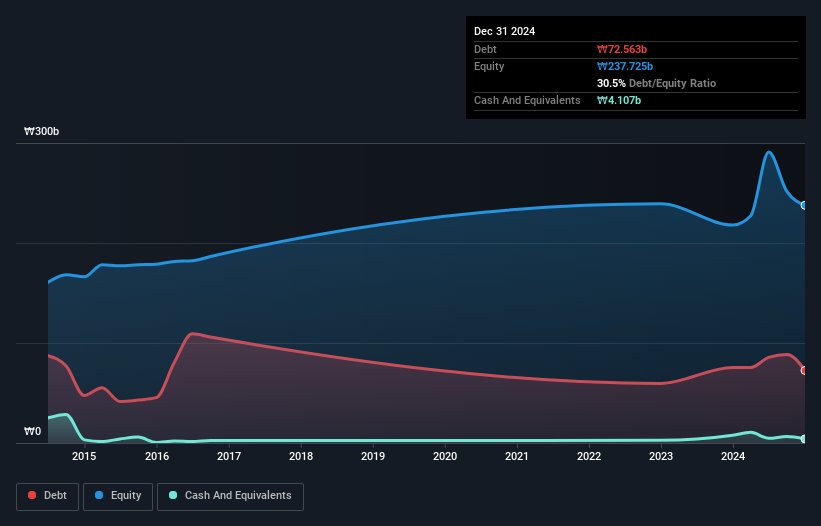
Legendary fund manager Li Lu (who Charlie Munger backed) once said, 'The biggest investment risk is not the volatility of prices, but whether you will suffer a permanent loss of capital.' When we think about how risky a company is, we always like to look at its use of debt, since debt overload can lead to ruin. We can see that SAJO SEAFOOD Co.,Ltd (KRX:014710) does use debt in its business. But should shareholders be worried about its use of debt?
Our free stock report includes 2 warning signs investors should be aware of before investing in SAJO SEAFOODLtd. Read for free now.Why Does Debt Bring Risk?
Generally speaking, debt only becomes a real problem when a company can't easily pay it off, either by raising capital or with its own cash flow. Part and parcel of capitalism is the process of 'creative destruction' where failed businesses are mercilessly liquidated by their bankers. While that is not too common, we often do see indebted companies permanently diluting shareholders because lenders force them to raise capital at a distressed price. Having said that, the most common situation is where a company manages its debt reasonably well - and to its own advantage. The first thing to do when considering how much debt a business uses is to look at its cash and debt together.
How Much Debt Does SAJO SEAFOODLtd Carry?
As you can see below, SAJO SEAFOODLtd had ₩72.6b of debt, at December 2024, which is about the same as the year before. You can click the chart for greater detail. However, it does have ₩4.11b in cash offsetting this, leading to net debt of about ₩68.5b.

How Strong Is SAJO SEAFOODLtd's Balance Sheet?
Zooming in on the latest balance sheet data, we can see that SAJO SEAFOODLtd had liabilities of ₩90.1b due within 12 months and liabilities of ₩9.95b due beyond that. On the other hand, it had cash of ₩4.11b and ₩13.9b worth of receivables due within a year. So it has liabilities totalling ₩82.1b more than its cash and near-term receivables, combined.
This is a mountain of leverage relative to its market capitalization of ₩89.4b. This suggests shareholders would be heavily diluted if the company needed to shore up its balance sheet in a hurry.
View our latest analysis for SAJO SEAFOODLtd
In order to size up a company's debt relative to its earnings, we calculate its net debt divided by its earnings before interest, tax, depreciation, and amortization (EBITDA) and its earnings before interest and tax (EBIT) divided by its interest expense (its interest cover). The advantage of this approach is that we take into account both the absolute quantum of debt (with net debt to EBITDA) and the actual interest expenses associated with that debt (with its interest cover ratio).
SAJO SEAFOODLtd has a rather high debt to EBITDA ratio of 5.1 which suggests a meaningful debt load. However, its interest coverage of 3.5 is reasonably strong, which is a good sign. One redeeming factor for SAJO SEAFOODLtd is that it turned last year's EBIT loss into a gain of ₩9.4b, over the last twelve months. There's no doubt that we learn most about debt from the balance sheet. But it is SAJO SEAFOODLtd's earnings that will influence how the balance sheet holds up in the future. So if you're keen to discover more about its earnings, it might be worth checking out this graph of its long term earnings trend.
Finally, while the tax-man may adore accounting profits, lenders only accept cold hard cash. So it is important to check how much of its earnings before interest and tax (EBIT) converts to actual free cash flow. Happily for any shareholders, SAJO SEAFOODLtd actually produced more free cash flow than EBIT over the last year. That sort of strong cash generation warms our hearts like a puppy in a bumblebee suit.
Our View
Neither SAJO SEAFOODLtd's ability handle its debt, based on its EBITDA, nor its level of total liabilities gave us confidence in its ability to take on more debt. But the good news is it seems to be able to convert EBIT to free cash flow with ease. When we consider all the factors discussed, it seems to us that SAJO SEAFOODLtd is taking some risks with its use of debt. While that debt can boost returns, we think the company has enough leverage now. When analysing debt levels, the balance sheet is the obvious place to start. But ultimately, every company can contain risks that exist outside of the balance sheet. Case in point: We've spotted 2 warning signs for SAJO SEAFOODLtd you should be aware of.
If you're interested in investing in businesses that can grow profits without the burden of debt, then check out this free list of growing businesses that have net cash on the balance sheet.
New: Manage All Your Stock Portfolios in One Place
We've created the ultimate portfolio companion for stock investors, and it's free.
• Connect an unlimited number of Portfolios and see your total in one currency
• Be alerted to new Warning Signs or Risks via email or mobile
• Track the Fair Value of your stocks
Have feedback on this article? Concerned about the content? Get in touch with us directly. Alternatively, email editorial-team (at) simplywallst.com.
This article by Simply Wall St is general in nature. We provide commentary based on historical data and analyst forecasts only using an unbiased methodology and our articles are not intended to be financial advice. It does not constitute a recommendation to buy or sell any stock, and does not take account of your objectives, or your financial situation. We aim to bring you long-term focused analysis driven by fundamental data. Note that our analysis may not factor in the latest price-sensitive company announcements or qualitative material. Simply Wall St has no position in any stocks mentioned.
About KOSE:A014710
SAJO SEAFOODLtd
Engages in the food, deep sea fishing, and frozen food storage businesses in South Korea.
Excellent balance sheet and good value.
Market Insights
Community Narratives



